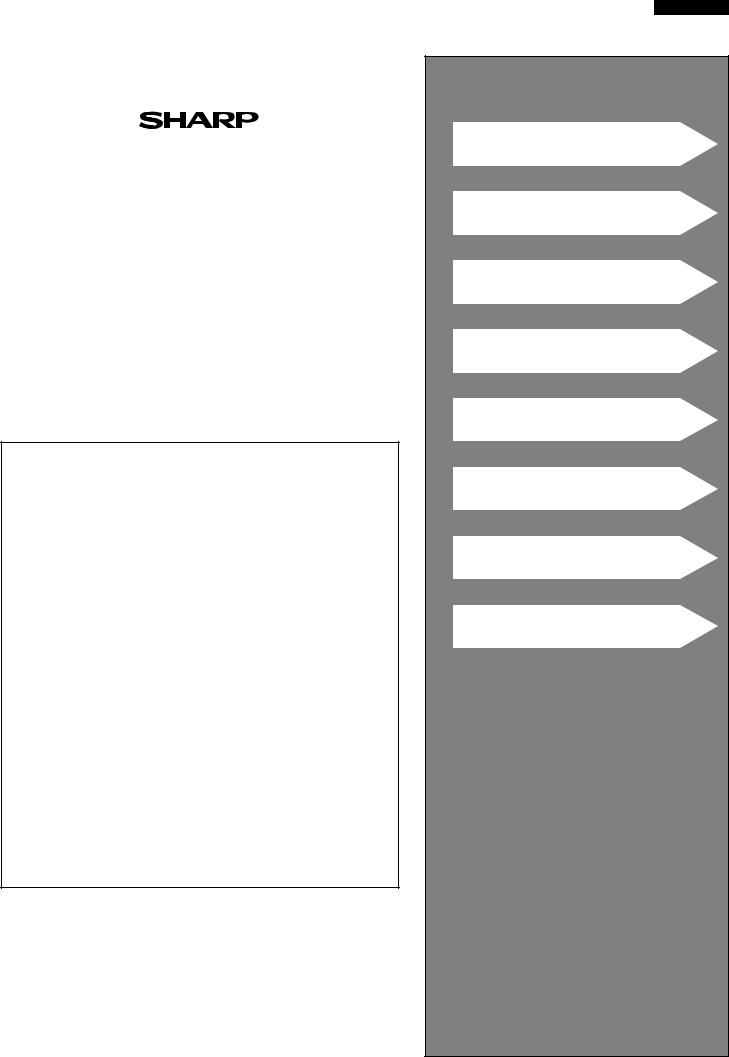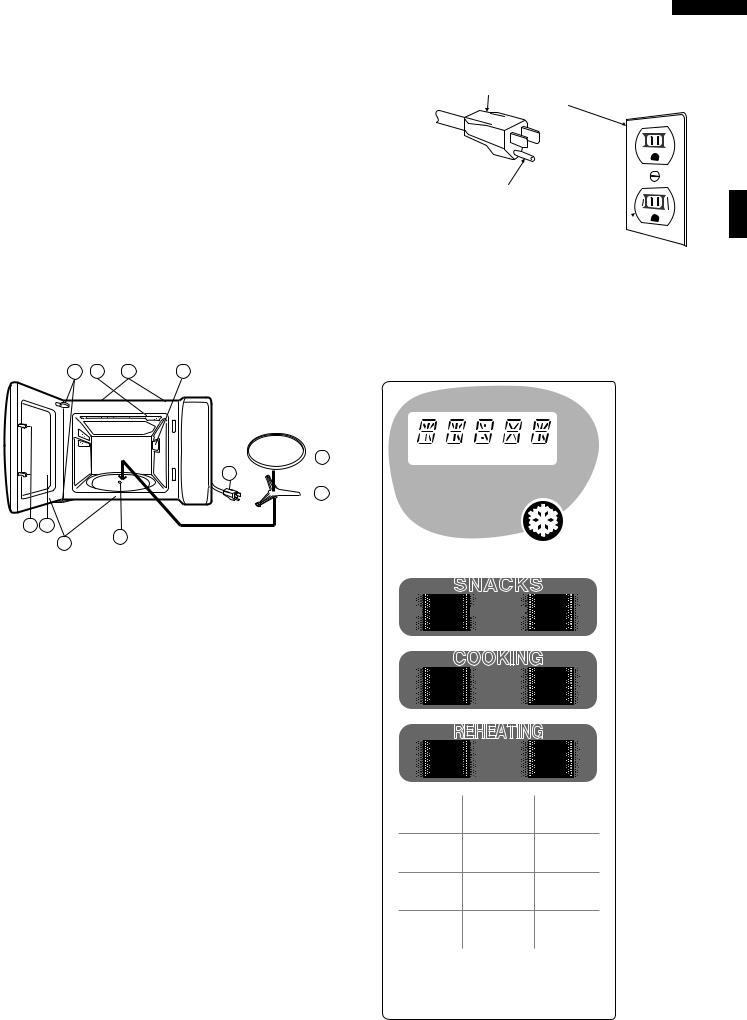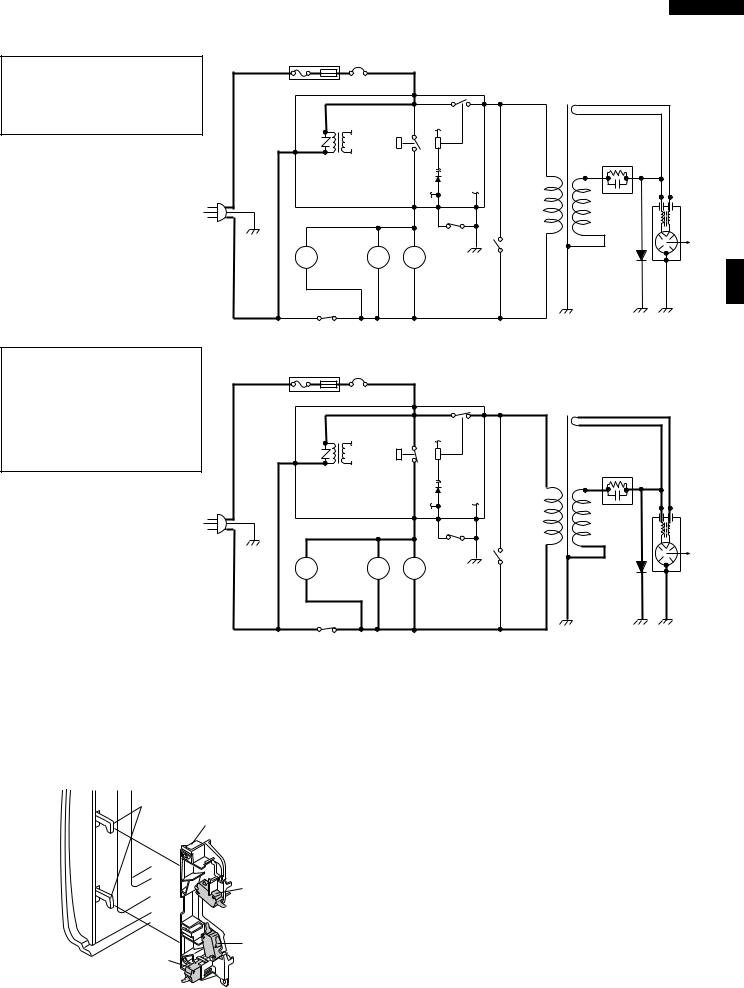SHARP R203CW2, R-203CW Service Manual

R-203CW


 SERVICE MANUAL
SERVICE MANUAL
|
ON DEF. |
|
LBS. |
QTY. CHECK |
|
1. Ground |
|
||||
meat |
|
|
|||
2. |
|
|
|
||
3. |
Steaks/chops |
|
|
||
|
Chicken pieces |
|
|||
To |
|
|
|
COMPU DEFROST |
|
|
adjust quantity-touch pad again |
||||
|
SNACKS |
||||
|
POPCORN |
|
|
BEVERAGE |
|
|
|
|
|
|
|
|
COOKING |
||||
|
BAKED |
|
|
|
FRESH |
|
POTATO |
|
|
||
|
|
|
|
|
VEGETABLES |
|
REHEATING |
||||
|
DINNER |
|
|
ROLL, |
|
|
PLATE |
|
|
|
|
|
|
|
|
|
MUFFIN |
|
1 |
|
|
2 |
3 |
|
4 |
|
|
||
|
|
|
5 |
6 |
|
|
7 |
|
|
||
|
|
|
8 |
||
|
|
|
9 |
||
Power |
|
|
|||
|
|
0 |
Timer |
||
Level |
|
|
|||
|
Stop |
|
|
|
Clock |
|
Clear |
|
|
|
START |
|
|
|
|
|
Minute Plus |
S2902R203CPW/
MICROWAVE OVEN
MODEL R-203CW
In the interest of user-safety the oven should be restored to its original condition and only parts identical to those specified should be used.
WARNING TO SERVICE PERSONNEL: Microwave ovens contain circuitry capable of producing very high voltage and current, contact with following parts may result in a severe, possibly fatal, electrical shock. (High Voltage Capacitor, High Voltage Power Transformer, Magnetron, High Voltage Rectifier Assembly, High Voltage Harness etc..)
TABLE OF CONTENTS |
|
|
Page |
PRECAUTIONS TO BE OBSERVED BEFORE AND DURING SERVICING TO |
|
AVOID POSSIBLE EXPOSURE TO EXCESSIVE MICROWAVE ENERGY ................... |
INSIDE FRONT COVER |
BEFORE SERVICING ...................................................................................................... |
INSIDE FRONT COVER |
WARNING TO SERVICE PERSONNEL ................................................................................................................ |
1 |
MICROWAVE MEASUREMENT PROCEDURE ................................................................................................... |
2 |
FOREWORD AND WARNING ............................................................................................................................... |
3 |
PRODUCT SPECIFICATIONS .............................................................................................................................. |
4 |
GENERAL INFORMATION ................................................................................................................................... |
4 |
OPERATION .......................................................................................................................................................... |
6 |
TROUBLESHOOTING GUIDE .............................................................................................................................. |
8 |
TEST PROCEDURE ............................................................................................................................................ |
10 |
TOUCH CONTROL PANEL ................................................................................................................................. |
17 |
COMPONENT REPLACEMENT AND ADJUSTMENT PROCEDURE ................................................................ |
21 |
PICTORIAL DIAGRAM ........................................................................................................................................ |
27 |
CONTROL PANEL CIRCUIT ............................................................................................................................... |
28 |
PRINTED WIRING BOARD ................................................................................................................................. |
29 |
PARTS LIST ........................................................................................................................................................ |
30 |
PACKING AND ACCESSORIES ......................................................................................................................... |
34 |
SHARP CORPORATION
This document has been published to be used for after sales service only.
The contents are subject to change without notice.

R-203CW
PRECAUTIONS TO BE OBSERVED BEFORE AND DURING SERVICING TO AVOID POSSIBLE EXPOSURE TO EXCESSIVE MICROWAVE ENERGY
(a)Do not operate or allow the oven to be operated with the door open.
(b)Make the following safety checks on all ovens to be serviced before activating the magnetron or other microwave source, and make repairs as necessary: (1) interlock operation, (2) proper door closing, (3) seal and sealing surfaces (arcing, wear, and other damage), (4) damage to or loosening of hinges and latches, (5) evidence of dropping or abuse.
(c)Before turning on microwave power for any service test or inspection within the microwave generating compartments, check the magnetron, wave guide or transmission line, and cavity for proper alignment, integrity, and connections.
(d)Any defective or misadjusted components in the interlock, monitor, door seal, and microwave generation and transmission systems shall be repaired, replaced, or adjusted by procedures described in this manual before the oven is released to the owner.
(e)A microwave leakage check to verify compliance with the Federal Performance Standard should be performed on each oven prior to release to the owner.
BEFORE SERVICING
Before servicing an operative unit, perform a microwave emission check as per the Microwave Measurement Procedure outlined in this service manual.
If microwave emissions level is in excess of the specified limit, contact SHARP ELECTRONICS CORPORATION immediately @1-800-237-4277.
If the unit operates with the door open, service person should 1) tell the user not to operate the oven and 2) contact SHARP ELECTRONICS CORPORATION and Food and Drug Administration's Center for Devices and Radiological Health immediately.
Service personnel should inform SHARP ELECTRONICS CORPORATION of any certified unit found with emissions in excess of 4mW/cm2. The owner of the unit should be instructed not to use the unit until the oven has been brought into compliance.

R-203CW
WARNING TO SERVICE PERSONNEL
Microwave ovens contain circuitry capable of producing very high voltage and current, contact with following parts may result in a severe, possibly fatal, electrical shock.
(Example)
High Voltage Capacitor, High Voltage Power Transformer, Magnetron, High Voltage Rectifier Assem-
bly, High Voltage Harness etc.. Read the Service Manual carefully and follow all
instructions.
Don't Touch ! Danger High Voltage
Before Servicing
1. Disconnect the power supply cord |
, and then |
remove outer case. |
|
2.Open the door and block it open.
3.Discharge high voltage capacitor.
WARNING:RISK OF ELECTRIC SHOCK. DISCHARGE THE HIGH-VOLTAGE CAPACITOR BEFORE SERVICING.
The high-voltage capacitor remains charged about 60 seconds after the oven has been switched off. Wait for 60 seconds and then short-circuit the connection of the highvoltage capacitor (that is the connecting lead of the highvoltage rectifier) against the chassis with the use of an insulated screwdriver.
Whenever troubleshooting is performed the power supply must be disconnected. It may in, some cases, be necessary to connect the power supply after the outer case has been removed, in this event,
1.Disconnect the power supply cord, and then remove outer case.
2.Open the door and block it open.
3.Discharge high voltage capacitor.
4.Disconnect the leads to the primary of the power transformer.
5.Ensure that the leads remain isolated from other components and oven chassis by using insulation tape.
6.After that procedure, reconnect the power supply cord.
When the testing is completed,
1.Disconnect the power supply cord, and then remove outer case.
2.Open the door and block it open.
3.Discharge high voltage capacitor.
4.Reconnect the leads to the primary of the power transformer.
5.Reinstall the outer case (cabinet).
6.Reconnect the power supply cord after the outer case is installed.
7.Run the oven and check all functions.
After repairing
1.Reconnect all leads removed from components during testing.
2.Reinstall the outer case (cabinet).
3.Reconnect the power supply cord after the outer case is installed.
4.Run the oven and check all functions.
Microwave ovens should not be run empty. To test for the presence of microwave energy within a cavity, place a cup of cold water on the oven turntable, close the door and set the power to HIGH and set the microwave timer for two (2) minutes. When the two minutes has elapsed (timer at zero) carefully check that the water is now hot. If the water remains cold carry out Before Servicing procedure and reexamine the connections to the component being tested.
When all service work is completed and the oven is fully assembled, the microwave power output should be checked and a microwave leakage test should be carried out.
1

R-203CW
MICROWAVE MEASUREMENT PROCEDURE
A. Requirements:
1)Microwave leakage limit (Power density limit): The power density of microwave radiation emitted by a microwave oven should not exceed 1mW/cm2 at any point 5cm or more from the external surface of the oven, measured prior to acquisition by a purchaser, and thereafter (through the useful life of the oven), 5 mW/cm2 at any point 5cm or more from the external surface of the oven.
2)Safety interlock switches Primary interlock relay and door sensing switch shall prevent microwave radiation emission in excess of the requirement as above mentioned, secondary interlock switch shall prevent microwave radiation emission in excess of 5 mW/cm2 at any point 5cm or more from the external surface of the oven.
B. Preparation for testing:
Before beginning the actual measurement of leakage, proceed as follows:
1) Make sure that the actual instrument is operating normally as specified in its instruction booklet.
Important:
Survey instruments that comply with the requirement for instrumentation as prescribed by the performance standard for microwave ovens, 21 CFR 1030.10(c)(3)(i), must be used for testing.
2)Place the oven tray in the oven cavity.
3)Place the load of 275±15 ml (9.8 oz) of tap water initially at 20±5˚C (68˚F) in the center of the oven cavity.
The water container shall be a low form of 600 ml (20 oz) beaker with an inside diameter of approx. 8.5 cm (3-1/2 in.) and made of an electrically nonconductive material such as glass or plastic.
The placing of this standard load in the oven is important not only to protect the oven, but also to insure that any leakage is measured accurately.
4)Set the cooking control on Full Power Cooking Mode
5)Close the door and select a cook cycle of several minutes. If the water begins to boil before the survey is completed, replace it with 275 ml of cool water.
C. Leakage test:
Closed-door leakage test (microwave measurement)
1)Grasp the probe of the survey instrument and hold it perpendicular to the gap between the door and the body of the oven.
2)Move the probe slowly, not faster than 1 in./sec. (2.5 cm/sec.) along the gap, watching for the maximum indication on the meter.
3)Check for leakage at the door screen, sheet metal seams and other accessible positions where the continuity of the metal has been breached (eg., around the switches, indicator, and vents).
While testing for leakage around the door pull the door away from the front of the oven as far as is permitted by the closed latch assembly.
4)Measure carefully at the point of highest leakage and make sure that the highest leakage is no greater than 4mW/cm2, and that the secondary interlock switch does turn the oven OFF before any door movement.
NOTE: After servicing, record data on service invoice and microwave leakage report.
2

SERVICE MANUAL
MICROWAVE OVEN
R-203CW
FOREWORD
This Manual has been prepared to provide Sharp Electronics Corp. Service Personnel with Operation and Service Information for the SHARP MICROWAVE OVEN, R-203CW.
It is recommended that service personnel carefully study the entire text of this manual so that they will be qualified to render satisfactory customer service.
Check the interlock switches and the door seal carefully. Special attention should be given to avoid electrical shock and microwave radiation hazard.
WARNING
Never operate the oven until the following points are ensured.
(A)The door is tightly closed.
(B)The door brackets and hinges are not defective.
(C)The door packing is not damaged.
(D)The door is not deformed or warped.
(E)There is no other visible damage with the oven.
Servicing and repair work must be carried out only by trained service personnel.
DANGER
Certain initial parts are intentionally not grounded and present a risk of electrical shock only during servicing. Service personnel - Do not contact the following parts while the appliance is energized;
High Voltage Capacitor, Power Transformer, Magnetron, High Voltage Rectifier Assembly, High Voltage Harness;
If provided, Vent Hood, Fan assembly, Cooling Fan Motor.
All the parts marked “*” on parts list are used at voltages more than 250V.
Removal of the outer wrap gives access to voltage above 250V.
All the parts marked “ ” on parts list may cause undue microwave exposure, by themselves, or when they are damaged, loosened or removed.
SHARP ELECTRONICS CORPORATION
SHARP PLAZA, MAHWAH,
NEW JERSEY 07430-2135
3
R-203CW
PRODUCT DESCRIPTION
GENERAL INFORMATION
OPERATION
TROUBLESHOOTING GUIDE AND TEST PROCEDURE
TOUCH CONTROL PANEL
COMPONENT REPLACEMENT AND ADJUSTMENT PROCEDURE
WIRING DIAGRAM
PARTS LIST

R-203CW
|
PRODUCT DESCRIPTION |
|
|
SPECIFICATIONS |
|
|
|
|
ITEM |
|
DESCRIPTION |
Power Requirements |
120 Volts |
|
|
60 Hertz |
|
|
Single phase, 3 wire grounded |
|
|
|
|
Power Consumption |
1100W / Approx. 9.5 Amperes |
|
|
|
|
Power Output |
700 W nominal of RF microwave energy (IEC 705 Test procedure) |
|
|
Operating frequency 2450 MHz |
|
|
|
|
Case Dimensions |
Width 18-1/8" |
|
|
Height 11-3/8" |
|
|
Depth 14-5/8" |
|
|
|
|
Cooking Cavity Dimensions |
Width 12-3/8" |
|
(0.7 Cubic feet) |
Height 7-7/8" |
|
|
Depth 12-5/8" |
|
|
|
|
Control Complement |
Touch Control System |
|
|
Clock (1:00 - 12:59) |
|
|
Timer (0 - 99 minutes 99 seconds) |
|
|
Microwave Power for Variable Cooking |
|
|
Repetition Rate; |
|
|
P-HI ................................... |
Full power throughout the cooking time |
|
P-90 .................................................... |
approx. 90% of FULL Power |
|
P-80 .................................................... |
approx. 80% of FULL Power |
|
P-70 .................................................... |
approx. 70% of FULL Power |
|
P-60 .................................................... |
approx. 60% of FULL Power |
|
P-50 .................................................... |
approx. 50% of FULL Power |
|
P-40 .................................................... |
approx. 40% of FULL Power |
|
P-30 .................................................... |
approx. 30% of FULL Power |
|
P-20 .................................................... |
approx. 20% of FULL Power |
|
P-10 .................................................... |
approx. 10% of FULL Power |
|
P-0 ...................................... |
No power throughout the cooking time |
|
COMPU DEFROST pad |
|
|
Instant Start pads |
|
|
Number selection pads |
|
|
Timer/Clock pad |
|
|
Power Level pad |
|
|
START/ Minute plus pad |
|
|
Stop/Clear pad |
|
|
|
|
Oven Cavity Light |
Yes |
|
|
|
|
Safety Standard |
UL Listed. |
|
|
FCC Authorized |
|
|
DHHS Rules, CFR, Title 21, Chapter 1, Subchapter J |
|
|
|
|
GENERAL INFORMATION
GROUNDING INSTRUCTIONS
This oven is equipped with a three prong grounding plug. It must be plugged into a wall receptacle that is properly installed and grounded in accordance with the National Electrical Code and local codes and ordinances.
In the event of an electrical short circuit, grounding reduces the risk of electric shock by providing an escape wire for the electric current.
WARNING: Improper use of the grounding plug can result in a risk of electric shock.
4

R-203CW
Electrical Requirements
The electrical requirements are a 115 -120 volt 60 Hz, AC only,
15 or 20 amp. fused electrical supply. It is recommended that a separate circuit serving only this appliance be provided. When installing this appliance, observe all applicable codes and ordinances.
A short power-supply cord is provided to reduce risks of becoming entangled in or tripping over a longer cord.
Where a two-pronged wall-receptacle is encountered, it is the personal responsibility and obligation of the customer to contact a qualified electrician and have it replaced with a properly grounded three-pronged wall receptacle or have a grounding adapter properly grounded and polarized. If the extension cord must be used, it should be a 3-wire, 15 amp. or higher rated cord. Do not drape over a countertop or table where it can be pulled on by children or tripped over accidentally.
3-Pronged Plug |
Grounded |
|
||
|
Receptacle Box |
|
||
|
|
|
|
|
|
|
|
|
|
|
|
|
|
|
|
|
|
|
|
Grounding Pin
3-Pronged Receptacle 
CAUTION: DO NOT UNDER ANY CIRCUMSTANCES CUT OR REMOVE THE ROUND GROUNDING PRONG FROM THIS PLUG.
OVEN DIAGRAM
3 |
9 |
8 |
10 |
 7
7
11

 6
6
2 1
45
1.Oven door with see-through window
2.Safety door latches.
3.Door hinges
4.Door seals and sealing surfaces
5.Turntable motor shaft
6.Removable turntable support
7.Removable turntable
8.Ventilation openings. (Rear)
9.Oven lamp.
10.Wave guide cover.
11.Power supply cord
TOUCH CONTROL PANEL
|
|
Time display |
|
|
|
ON DEF. LBS. QTY. CHECK |
|
Indicator |
|
1.Ground meat
2.Steaks/chops
3. Chicken pieces
COMPU DEFROST
To adjust quantity-touch pad again
SNACKS
 POPCORN
POPCORN
 BEVERAGE
BEVERAGE
COOKING
BAKED |
FRESH |
POTATO |
VEGETABLES |
REHEATING
DINNER |
ROLL, |
PLATE |
MUFFIN |
1 |
2 |
3 |
|
4 |
5 |
6 |
|
7 |
8 |
9 |
|
Power |
0 |
Timer |
|
Level |
Clock |
||
|
Stop |
|
START |
|
Clear |
|
Minute Plus |
5

R-203CW
OPERATION
DESCRIPTION OF OPERATING SEQUENCE
The following is a description of component functions during oven operation.
OFF CONDITION
Closing the door activates the door sensing switch and secondary interlock switch. (In this condition, the monitor switch contacts are opened.)
When the oven is plugged in, 120 volts A.C. is supplied to the control unit. (Figure O-1).
1.The display will show flashing "88:88".
To set any program or set the clock, you must first touch the STOP/CLEAR pad. The display will clear, and " : " will appear.
COOKING CONDITION
Program desired cooking time by touching the NUMBER pads. And program the power level by touching the POWER LEVEL pad and then a Number pad.
When the START pad is touched, the following operations occur:
1.The contacts of the relays are closed and components connected to the relays are turned on as follows.
(For details, refer to Figure O-2)
RELAY |
CONNECTED COMPONENTS |
RY-1 |
oven lamp/turntable motor/fan motor |
|
|
RY-2 |
power transformer |
|
|
2.120 volts A.C. is supplied to the primary winding of the power transformer and is converted to about 3.5 volts A.C. output on the filament winding, and approximately 2000 volts A.C. on the high voltage winding.
3.The filament winding voltage heats the magnetron filament and the H.V. winding voltage is sent to a voltage doubler circuit.
4.The microwave energy produced by the magnetron is channelled through the waveguide into the cavity feedbox, and then into the cavity where the food is placed to be cooked.
5.Upon completion of the cooking time, the power transformer, oven lamp, etc. are turned off, and the generation of microwave energy is stopped. The oven will revert to the OFF condition.
6.When the door is opened during a cook cycle, the monitor switch, door sensing switch, secondary interlock switch and primary interlock relay are activated with the following results. The circuits to the oven lamp, turntable motor, the cooling fan motor, and the high voltage components are de-energized, and the digital read-out displays the time still remaining in the cook cycle when the door was opened.
7.The monitor switch is electrically monitoring the operation of the secondary interlock switch and primary interlock
relay (RY2) and is mechanically associated with the door so that it will function in the following sequence.
(1)When the door opens from the closed position, the secondary interlock switch, door sensing switch and primary interlock relay (RY2) open their contacts. Then the monitor switch contacts close.
(2)When the door is closed from the open position, the monitor switch contacts open first. Then the contacts of the secondary interlock switch and door sensing switch close.
If the secondary interlock switch and primary interlock relay (RY2) fail with the contacts closed when the door is opened, the closing of the monitor switch contacts will form a short circuit through the C/T fuse and primary interlock relay (RY2), causing the C/T fuse to blow.
POWER LEVEL P-0 TO P-90 COOKING
When Variable Cooking Power is programmed, the 120 volts A.C. is supplied to the power transformer intermittently through the contacts of relay (RY-2) which is operated by the control unit within a 32 second time base. Microwave power operation is as follows:
VARI-MODE |
ON TIME |
OFF TIME |
Power 10(P-HI) |
32 sec. |
0 sec. |
(100% power) |
|
|
Power 9(P-90) |
30 sec. |
2 sec. |
(approx. 90% power) |
|
|
Power 8(P-80) |
26 sec. |
6 sec. |
(approx. 80% power) |
|
|
Power 7(P-70) |
24 sec. |
8 sec. |
(approx. 70% power) |
|
|
Power 6(P-60) |
22 sec. |
10 sec. |
(approx. 60% power) |
|
|
Power 5(P-50) |
18 sec. |
14 sec. |
(approx. 50% power) |
|
|
Power 4(P-40) |
16 sec. |
16 sec. |
(approx. 40% power) |
|
|
Power 3(P-30) |
12 sec. |
20 sec. |
(approx. 30% power) |
|
|
Power 2(P-20) |
8 sec. |
24 sec. |
(approx. 20% power) |
|
|
Power 1(P-10) |
6 sec. |
26 sec. |
(approx. 10% power) |
|
|
Power 0(P-0) |
0 sec. |
32 sec. |
(0% power) |
|
|
Note: The ON/OFF time ratio does not correspond with the percentage of microwave power, because approx. 2 seconds are needed for heating of the magnetron filament.
6

R-203CW
|
C/T FUSE |
MAGNETRON |
|
|
|
|
SCHEMATIC |
THERMAL CUT-OUT |
|
|
|
|
|
|
|
|
|
NOTE: CONDITION OF OVEN |
|
COM. |
|
POWER |
|
|
|
|
|
|
|
1. |
DOOR CLOSED |
|
|
N.O. |
TRANSFORMER |
|
|
|
|
||
2. |
CLOCK APPEARS ON DISPLAY |
|
|
|
|
|
A3 |
(RY-1) |
(RY-2) |
|
|
|
|
|
PRIMARY |
|
|
|
|
|
|
|
|
|
|
|
|
INTERLOCK |
|
|
|
|
|
RELAY |
|
|
CONTROL UNIT |
|
|
|
CAPACITOR |
|
|
|
|
0.86 F |
|
|
|
|
|
|
|
|
GRN |
A1 |
B1 |
B2 |
|
|
|
|
|
|
|
120V AC |
|
|
DOOR |
|
60 Hz |
|
|
|
|
|
|
|
SENSING |
MONITOR |
|
|
|
SWITCH |
|
|
|
|
SWITCH |
|
|
|
|
|
|
OL |
TTM |
FM |
|
RECTIFIER |
|
|
|
|
MAGNETRON |
OVEN |
TURN- |
FAN |
|
|
LAMP |
TABLE |
MOTOR |
|
|
|
MOTOR |
|
|
|
SECONDARY |
|
|
|
|
INTERLOCK |
|
|
|
|
SWITCH |
|
|
|
|
SCHEMATIC
NOTE: CONDITION OF OVEN
1.DOOR CLOSED
2.COOKING TIME PROGRAMMED
3.VARIABLE COOKING CONTROL "HIGH"
4."START" PAD TOUCHED
Figure O-1. Oven Schematic-Off Condition
C/T FUSE |
MAGNETRON |
|
THERMAL CUT-OUT |
|
COM. |
|
POWER |
|
|
|
|
|
|
N.O. |
TRANSFORMER |
(RY-1) |
(RY-2) |
|
|
A3 |
|
PRIMARY |
|
|
|
INTERLOCK |
|
|
|
RELAY |
|
CONTROL UNIT |
|
|
CAPACITOR |
|
|
0.86 F |
|
|
|
|
|
A1 |
B1 |
B2 |
|
GRN
120V AC |
|
|
DOOR |
|
60 Hz |
|
|
|
|
|
|
|
SENSING |
MONITOR |
|
|
|
SWITCH |
|
|
|
|
SWITCH |
|
|
|
|
|
|
OL |
TTM |
FM |
|
RECTIFIER |
|
|
|
|
MAGNETRON |
OVEN |
TURN- |
FAN |
|
|
LAMP |
TABLE |
MOTOR |
|
|
|
MOTOR |
|
|
|
SECONDARY |
|
|
|
|
INTERLOCK |
|
|
|
|
SWITCH |
|
|
|
|
Figure O-2. Oven Schematic-Cooking Condition
DESCRIPTION AND FUNCTION OF COMPONENTS
DOOR OPEN MECHANISM
The door is opened by pulling the door, refer to the Figure D-1.
Latch Heads
Latch Hook
|
|
Door |
|
|
Sensing |
|
|
Switch |
|
|
Monitor |
Door |
Secondary |
Switch |
Interlock |
|
|
|
|
|
|
Switch |
|
Figure D-1. Door Open Mechanism
DOOR SENSING AND SECONDARY INTERLOCK SWITCHES
The secondary interlock switch is mounted in the lower position of the latch hook and the door sensing switch in the primary interlock system is mounted in the upper position of the latch hook. They are activated by the latch heads on the door. When the door is opened, the switches interrupt the power to all high voltage components. A cook cycle cannot take place until the door is firmly closed thereby activating both interlock switches. The primary interlock system consists of the door sensing switch and primary interlock relay located on the control circuit board.
MONITOR SWITCH
The monitor switch is activated (the contacts opened) by the latch head on the door while the door is closed. The switch is intended to render the oven inoperative, by means of
7

R-203CW
blowing the C/T fuse, when the contacts of the primary interlock relay (RY2) and secondary interlock switch fail to open when the door is opened.
Functions:
1.When the door is opened, the monitor switch contacts close (to the ON condition) due to their being normally closed. At this time the primary interlock relay (RY2) and secondary interlock switch are in the OFF condition (contacts open) due to its being normally open contact switches.
2.As the door goes to a closed position, the monitor switch contacts are first opened and then the door sensing switch and secondary interlock switch contacts close.
3.If the door is opened, and the primary interlock relay (RY2) and the secondary interlock switch contact fail to open, the C/T fuse blows simultaneously with closing of the monitor switch contacts.
CAUTION: BEFORE REPLACING A BLOWN C/T FUSE, TEST THE DOOR SENSING SWITCH, PRIMARY INTERLOCK RELAY (RY2), SECONDARY INTERLOCK SWITCH AND MONITOR SWITCH FOR PROPER OPERATION. (REFER TO CHAPTER "TEST PROCEDURE").
NOTE: C/T FUSE AND MONITOR SWITCH ARE REPLACED AS AN ASSEMBLY
TURNTABLE MOTOR
The turntable motor rotates the turntable located on the bottom of the oven cavity, so that the food on the turntable is cooked evenly. The turntable may turn in either direction.
COOLING FAN MOTOR
The cooling fan motor drives a blade which draws external
cool air. This cool air is directed through the air vanes surrounding the magnetron and cools the magnetron. This air is channelled through the oven cavity to remove steam and vapours given off from the heating foods. It is then exhausted through the exhausting air vents at the oven cavity.
MAGNETRON THERMAL CUT-OUT
The thermal cut-out located on the top of the oven cavity is designed to prevent damage to the magnetron if an over heated condition develops in the tube due to cooling fan failure, obstructed air guide, dirty or blocked air intake, etc. Under normal operation, the thermal cut-out remains closed. However, when abnormally high temperatures are reached within the magnetron, the thermal cut-out will open at 257˚F (125˚C), causing the oven to shut down.
C/T FUSE
1.The C/T fuse blows when the contacts (COM-NO) of the primary interlock relay (RY2) and secondary interlock switch remain closed with the oven door open and when the monitor switch closes.
2.If the wire harness or electrical components are shortcircuited, this C/T fuse blows to prevent an electric shock or fire hazard.
3.The C/T fuse, located on the top of the oven cavity, is designed to prevent damage to the oven by fire. If the food load is overcooked, by either error in cook time or defect in the timer, the C/T fuse will open.
Under normal operation, the C/T fuse remains closed. However, when abnormally high temperatures are reached within the oven cavity, the C/T fuse will open at 248˚F (120˚C), causing the oven to shut down or when the electric currents beyond 13A flow, the C/T fuse will open.
TROUBLESHOOTING GUIDE
Never touch any part in the circuit with your hand or an uninsulated tool while the power supply is connected.
When troubleshooting the microwave oven, it is helpful to follow the Sequence of Operation in performing the checks. Many of the possible causes of trouble will require that a specific test be performed. These tests are given a procedure letter which will be found in the "Test Procedure "section.
IMPORTANT: If the oven becomes inoperative because of a blown C/T fuse, check the monitor switch, primary interlock relay (RY2), door sensing switch and secondary interlock switch before replacing the C/T fuse. If the C/T fuse is replaced, the monitor switch must also be replaced. Use part FFS-BA020WRK0 as an assembly.
IMPORTANT: Whenever troubleshooting is performed with the power supply cord disconnected. It may in, some cases, be necessary to connect the power supply cord after the outer case has been removed, in this event,
1.Disconnect the power supply cord, and then remove outer case.
2.Open the door and block it open.
3.Discharge high voltage capacitor.
8

R-203CW
4.Disconnect the leads to the primary of the power transformer.
5.sge that the leads remain isolated from other components and oven chassis by using insulation tape.
6.After that procedure, reconnect the power supply cord.
When the testing is completed,
1.Disconnect the power supply cord, and then remove outer case.
2.Open the door and block it open.
3.Discharge high voltage capacitor.
4.Reconnect the leads to the primary of the power transformer.
5.Reinstall the outer case (cabinet).
6.Reconnect the power supply cord after the outer case is installed.
7.Run the oven and check all functions.
CK = Check / RE = Replace
TEST PROCEDURE
POSSIBLE CAUSE
AND
DEFECTIVE PARTS
CONDITION |
PROBLEM |
|
|
Home fuse blows when power cord |
|
|
is plugged into wall receptacle. |
|
|
C/T fuse blows when power cord is |
|
|
plugged into wall receptacle. |
|
|
All letters and indicators do not ap- |
|
|
pear in display when power cord is |
|
OFF |
first plugged into wall outlet. |
|
|
||
CONDITION |
Display does not operate properly |
|
|
||
|
when STOP/CLEAR key is touched. |
|
|
(Buzzer should sound and time of |
|
|
day should appear in display.) |
|
|
C/T fuse blows when the door is |
|
|
opened. |
|
|
Fan motor does not operate. (All |
|
|
other electric components function.) |
|
|
Oven lamp does not light at all. (All |
|
|
other electric components function.) |
|
|
Turntable motor does not operate. (All |
|
|
other electric components function.) |
|
|
Oven does not go into cook cycle |
|
|
when START pad is touched |
|
COOKING |
Oven seems to be operating but little |
|
or no heat is produced in oven load. |
||
CONDITION |
||
(Food incompletely cooked or not |
||
|
||
|
cooked at all at end of cook cycle.) |
|
|
Oven goes into a cook cycle but |
|
|
extremely uneven heating is pro- |
|
|
duced in oven load (food). |
|
|
Oven does not cook properly when |
|
|
programmed for Cooking Power 5 |
|
|
mode. (Operates properly on Cook- |
|
|
ing Power 10 (HIGH) mode.) |
|
|
Oven lamp, turntable motor and fan |
|
|
motor do not operate. |
|
|
Oven goes into EXPRESS DEFROST |
|
|
but food is not defrosted well. |
RE |
CK |
A |
B |
C |
D |
E |
F |
F |
G |
H |
RE |
RE |
CK |
I/K |
CK |
CK |
CK |
J |
L |
M |
SHORT IN POWER CORD |
SHORT OR OPEN WIRING |
MAGNETRON |
POWER TRANSFORMER |
H.V. RECTIFIER ASSEMBLY |
HIGH VOLTAGE CAPACITOR |
MAGNETRON THERMAL CUT-OUT |
PRIMARY INTERLOCK SYSTEM |
SECONDARY INTERLOCK SWITCH |
MONITOR SWITCH |
C/T FUSE |
OVEN LAMP OR SOCKET |
COOLING FAN MOTOR |
TURNTABLE MOTOR |
CONTROL UNIT OR RELAY |
WRONG OPERATION |
LOW VOLTAGE |
DIRTY OVEN CAVITY |
KEY UNIT |
EXPRESS DEFROST |
FOIL PATTERN ON PWB. |
|
|
|
|
|
|
|
|
|
|
|
|
|
|
|
|
|
|
|
|
|
9
